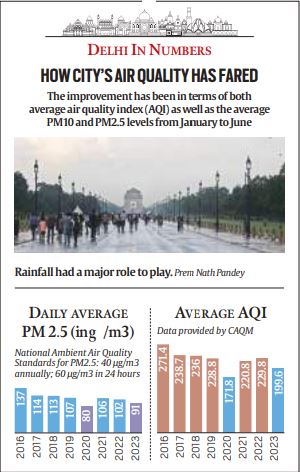Delhi saw its cleanest Jan-June air this year in eight years — save for just one exception
The improvement has been in terms of both average air quality index (AQI) as well as the average PM10 and PM2.5 levels from January to June.
 From January to June this year, Delhi has recorded 101 days when the AQI was 200 or lower, which means that the AQI was in the ‘satisfactory’ (from 51 to 100) or ‘moderate’ (from 101 to 200) categories. (Express file)
From January to June this year, Delhi has recorded 101 days when the AQI was 200 or lower, which means that the AQI was in the ‘satisfactory’ (from 51 to 100) or ‘moderate’ (from 101 to 200) categories. (Express file) From January to June this year, Delhi has seen the cleanest air for the period in the past eight years – except for 2020, the year the first Covid-induced lockdown was imposed, according to the Commission for Air Quality Management (CAQM).
The improvement has been in terms of both average air quality index (AQI) as well as the average PM10 and PM2.5 levels from January to June. The average AQI from January to June this year was 199.6, the lowest 2016 onwards, except for the average AQI for this period in 2020, which was 171.8. Similarly, the average PM10 level from January to June this year was 202 µg/m3, which is the lowest for the period 2016 onwards, save for 2020, when it was at a lower figure of 158 µg/m3. The PM2.5 level so far this year has been 91 µg/m3, also the lowest for this period from 2016, except for the 80 µg/m3 recorded in 2020.
A communication from the CAQM attributed the improved air quality to meteorological conditions and “concerted efforts.” The CAQM said in its communication: “Favourable meteorological/ weather conditions coupled with consistent, comprehensive and concerted efforts by the CAQM and various stakeholders to control air pollution in the National Capital Region helped in achieving better overall air quality in Delhi during the first half of the current year.”
From January to June this year, Delhi has recorded 101 days when the AQI was 200 or lower, which means that the AQI was in the ‘satisfactory’ (from 51 to 100) or ‘moderate’ (from 101 to 200) categories. This is the highest number of such days 2016 onwards, except for 2020, according to the data provided by CAQM. While there were 30 days with AQI at 200 or lower from January to June 2016, 57 such days were recorded in the period in 2017, 65 in 2018, 78 days in 2019, 126 in 2020, 84 in 2021, and 54 in 2022.

A ’good’ air day (AQI of 50 or less) has, however, eluded Delhi so far this year. Data from the Central Pollution Control Board (CPCB) shows that there were no such ‘good’ air days from January to June in 2021 and 2022 either. In 2020, when a lockdown was in place in March, there was a single ‘good’ air day from January to June – on March 28. There were no ‘good’ air days from January to June in 2017, 2018 and 2019.
Anumita Roychowdhury at the Centre for Science and Environment (CSE) said, “That also shows you how obstinate the pollution is…that even if you have the washout effect of rains, to be able to meet levels of ‘good’ air quality, you can’t rely on rains. Rains help you clear away coarser particles and finer particles remain in the air. Gases also still remain a challenge, and AQI during the monsoon months shows that lead pollutants are often gases and not particulate matter.”
According to the CPCB, ‘good’ AQI has minimal health impact, while ‘satisfactory’ AQI can cause ‘minor breathing discomfort to sensitive people’, and ‘moderate’ AQI can lead to ‘breathing discomfort to people with asthma, and lung and heart diseases.’
Rainfall had a major role to play
The meteorological condition that the CAQM attributed the improved air quality to is rainfall. In June this year, there have been 17 rainy days, including days when less than 1 mm of rain was recorded, and a total of 101.7 mm of rainfall. This is the highest number of rainy days at least 2011 onwards, and the highest amount of rainfall for the month 2018 onwards, according to data from the India Meteorological Department (IMD). There was a lower amount of rainfall (34.5 mm) in 2016 as well, while 2017 saw a higher amount – of 191.9 mm.
Remnants of Cyclone Biparjoy and western disturbances, followed by the monsoon towards the end of the month, brought above-normal rainfall to northwest India in June this year.
Said Roychowdhury: “This year, there has been intermittent rainfall, even in May, when we usually see high dust levels. There is a downward trend and better air quality days have been increasing, but there is a long way to go to attain the clean air benchmark, which can really minimise public health impacts. WHO standards for PM2.5 are at this point challenging to meet, but we need to see more stringent action at the local level and the airshed or regional level.”







